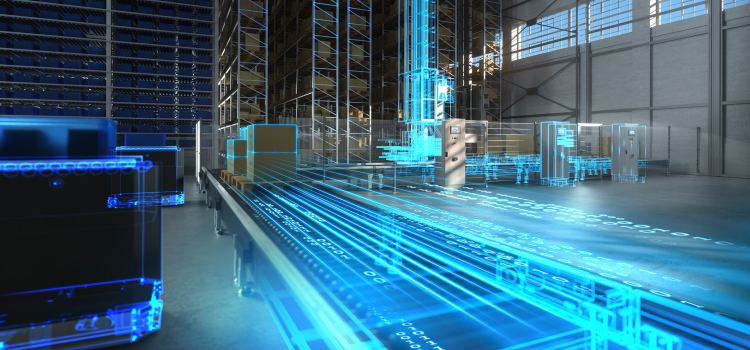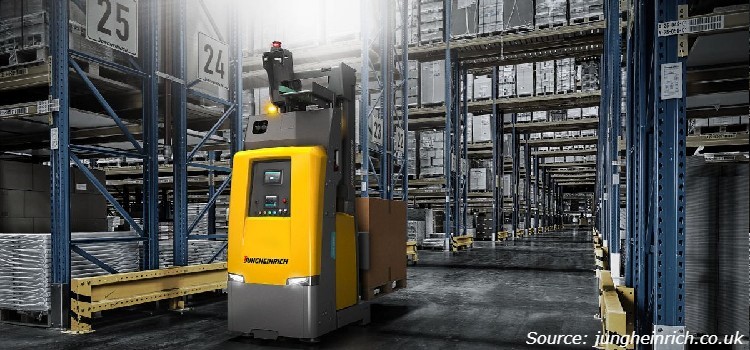
Intralogistics Market by Component (Hardware, Software, and Services), and by End User Industry (Logistics, Food & Beverages, Retail & E-commerce, Automotive, Chemicals, Pharmaceuticals, Airport, and Mining) – Global Opportunity Analysis and Industry Forecast 2024–2030
Industry: Construction & Manufacturing | Publish Date: 23-Apr-2024 | No of Pages: 379 | No. of Tables: 250 | No. of Figures: 215 | Format: PDF | Report Code : N/A
Market Overview:
The global Intralogistics Market was valued at USD 43.13 billion in 2023, and is predicted to reach USD 115.92 billion by 2030, with a CAGR of 15.2% from 2024 to 2030. Intralogistics industry refers to the planning, management, and execution of the movement and storage of materials, goods, and information within a facility or warehouse. It includes all the internal logistics activities that occur within a single company, such as receiving, warehousing, picking, packing, and shipping of goods. This involves the use of various technologies, such as automated material handling systems, conveyors, robotics, sensors, and software applications.
Intralogistics includes the design, development, implementation, and management of systems and technologies used to optimize and streamline the movement, storage, and retrieval of goods and materials. They help companies to improve their supply chain management, reduce lead times, improve order accuracy, and enhance customer service.
Adoption of Industry 4.0 Boosts the Growth of Intralogistics Industry
The adoption of Industry 4.0, also known as the fourth industrial revolution, has significantly impacted the intralogistics industry by enhancing the overall efficiency and productivity of the supply chain. In addition, the integration of Industry 4.0 technologies has led to the development of smart warehouses, which are highly automated and connected.
Smart warehouses use advanced technologies such as sensors, RFID tags, and automated storage & retrieval systems (AS/RS) to streamline inventory management, order processing, and fulfillment. For instance, in October 2021, Zyter implemented a state-of-the-art, next-generation smart warehouse for OneScreen, located in San Diego that is equipped with products from Qualcomm Technologies, Inc.
Growing Adoption of Intralogistics Systems in E-Commerce Industry Fuels the Market Demand.
The rise of e-commerce has revolutionized the retail industry, and with it, the demand for intralogistics has increased significantly. As e-commerce continues to gain popularity, the need for efficient and streamlined intralogistics operations has become paramount. According to the report published by Forbes in February 2022, E-Commerce sales were USD 870 billion in the U.S. in 2021, a 14.2% increase over 2020 and a 50.5% increase over 2019.
In addition, the growing popularity of online shopping has resulted in an increase in order volume, faster turnaround times, and the need for a more diverse range of products. As a result, the logistics industry has had to adapt and invest in new technologies such as automation, robotics, and artificial intelligence to meet these demands.
For instance, in March 2020, Dematic introduced the latest generation of warehouse automation solutions called Multishuttle (DMS) 2 E. The system stores, buffers and sequences products for order picking and compilation and is compatible with all other DMS components.
High Installation Cost of Intralogistics Systems Glooming the Market Growth
The high installation cost of intralogistics systems can be a significant barrier to adoption, and can limit the market prospects for these systems. Intralogistics systems typically require significant investments in technology and infrastructure, including specialized equipment, software, and hardware, as well as the cost of installation and maintenance.
This high upfront cost can be prohibitive for some businesses, particularly small and medium-sized enterprises (SMEs), which may have limited resources to invest in these systems. Additionally, the cost of intralogistics systems can be influenced by factors such as the size and complexity of the operation, the level of customization required, and the degree of automation desired. As a result, some businesses may opt for less expensive and less efficient alternatives, which can limit the growth and adoption of intralogistics systems in the market.
Introduction of Drones in Intralogistics Industry to Create Future Market Prospects
The introduction of drones in intralogistics has the potential to create significant growth opportunities for businesses that rely on efficient supply chain operations. Drones, also known as unmanned aerial vehicles (UAVs), are being used in intralogistics to automate a range of tasks, including inventory management, order picking, and delivery.
By leveraging drone technology, businesses can reduce the time and costs associated with manual labor and transportation, as well as improve the accuracy and speed of their operations. Drones can also provide greater flexibility and scalability in intralogistics, enabling businesses to adapt to changes in demand and respond quickly to customer needs. Moreover, drones can improve efficiency and reduce the risk of accidents or injuries for workers who might otherwise need to use ladders or other equipment to access these areas.
In addition, drones can gather information on inventory levels, product quality, and other key metrics, providing businesses with valuable insights into their operations by using sensors and cameras. This data can be used to optimize processes, improve forecasting, and reduce waste, leading to cost savings and improved efficiency.
North America is Projected to Dominate the Intralogistics Market
The North American region consists of U.S., Canada, and Mexico. The intralogistics market in North America is driven by a number of factors such as advancements in technology, the need for improved efficiency & productivity, along with the increasing availability and affordability of automated systems. Several industries such as automotive, consumer goods, and electronics, are among the leading adopters of intralogistics in North America.
In addition, North America is home to some of the world's largest and most innovative companies in the field of automation, and continues to lead the way in terms of investment and research development. The rising trend towards industrial automation is expected to boost the market growth.
For instance, in March 2022, Material Handling System Global (MHS global) collaborated with Hai Robotics and Mujin to launch fully automated order fulfilment solution. The collaboration was aimed at developing warehouse execution system (WES) that integrates the various automated components and robotics technology together to work as a smart, efficient system.
Furthermore, advances in areas such as artificial intelligence and machine learning are also expected to play a significant role in the future of industrial automation, enabling companies to optimize their operations and gain a competitive advantage that drives the growth of the intralogistics market in this region.
Asia-Pacific Witnessed Substantial Growth in Intralogistics Industry
The intralogistics market in Asia Pacific region is expanding significantly, propelled by a number of factors that are raising demand for logistics services that are more effective and dependable. The expansion of e-commerce, which has fueled the demand for quicker and more precise order fulfilment procedures, is one of the main factors contributing to this expansion. This has increased the need for intralogistics services, such as order fulfilment, inventory management, and warehousing.
Another factor driving the growth of the intralogistics market in the Asia Pacific region is the increasing investment in infrastructure development. Governments in countries such as China, India, and Indonesia have been investing heavily in infrastructure, including the construction of new airports, seaports, and highways. This has improved transportation networks and made it easier to move goods around the region.
Moreover, the adoption of automation and robotics in warehouse and logistics operations is increasing, leading to improved efficiency and cost savings for companies. For instance, in May 2022, Attabotics, the world’s first 3D robotics supply chain system for modern commerce exclusively partnered with SYNUS Tech, a logistics automation company to provide integrated logistics system warehouse solutions to the South Korean markets.
Moreover, the development of free trade agreements and increasing globalization is further driving the growth of the intralogistics market in the region. As trade volumes continue to increase, there is a greater need for efficient and reliable logistics solutions, which is driving the demand for intralogistics services.
Competitive Landscape
The intralogistics industry includes various market players such as Daifuku Co. Ltd., Jungheinrich AG, Kion Group AG, Honeywell International Inc., Midea Group, Vanderlande, SSI Schaefer AG, KNAPP Group, Beumer Group GmbH and Co. KG, Autostore and others. These market players are adopting several strategies such as product launches, acquisition, and innovation across various regions to maintain their dominance in the intralogistics market.
For instance, in February 2023, SSI Schaefer Group signed an agreement, under which the company will acquire the remaining shares of DS Automotion, a provider of AGVs and AMRs. The acquisition of the remaining shares will take effect on March 2023. This development represents an important milestone in strengthening the company's competitiveness and innovation power in robotics and automation, that are pioneering for intralogistics.
In addition, in June 2022, Daifuku Co., Ltd. announced the reopening of Hini Arata Kan, one of the world’s largest full-scale material handling and logistics demo centers, located within Daifuku’s manufacturing plant Shiga Works, Japan. The renewal has added 54 of Daifuku’s latest material handling systems and equipment to the center, as well as adding large displays for visitors to watch case studies and other videos of the systems in action on-site.
KEY BENEFITS
-
The report provides a quantitative analysis and estimations of the intralogistics market from 2024 to 2030, which assists in identifying the prevailing market opportunities.
-
The study comprises a deep-dive analysis of the current and future intralogistics market trends to depict prevalent investment pockets in the market.
-
Information related to key drivers, restraints, and opportunities and their impact on the intralogistics market is provided in the report.
-
Competitive analysis of the players, along with their market share is provided in the report.
-
A SWOT analysis and the Porter's Five Forces model is elaborated on in the study.
-
Value chain analysis in the market study provides a clear picture of roles of stakeholders.
INTRALOGISTICS MARKET KEY SEGMENTS
By Component
-
Hardware
-
Automated Storage and Retrieval Systems (AS/RS)
-
Unit-Load AS/RS
-
Mini-Load AS/RS
-
Vertical Lift Modules (VLMs)
-
Carousel AS/RS
-
-
Industrial Robots
-
Mobile Robots
-
Automated Guided Vehicles (AGV)
-
Autonomous Mobile Robots (AMR)
-
-
Conveyor Systems
-
Sortation Systems
-
-
Software
-
Services
By End User Industry
-
Logistics
-
Food and Beverages
-
Retail and E-Commerce
-
Automotive
-
Chemicals
-
Pharmaceuticals
-
Airport
-
Mining
By Region
-
North America
-
U.S
-
Canada
-
Mexico
-
-
Europe
-
Germany
-
UK
-
France
-
Italy
-
Spain
-
Denmark
-
Netherlands
-
Finland
-
Sweden
-
Norway
-
Russia
-
Rest of Europe
-
-
Asia-Pacific
-
China
-
Japan
-
India
-
South Korea
-
Australia
-
Indonesia
-
Singapore
-
Taiwan
-
Thailand
-
Rest of Asia-Pacific
-
-
RoW
-
Latin America
-
Middle East
-
Africa
-
REPORT SCOPE AND SEGMENTATION:
|
Parameters |
Details |
|
Market Size in 2023 |
USD 43.13 Billion |
|
Revenue Forecast in 2030 |
USD 115.92 Billion |
|
Growth Rate |
CAGR of 15.2% from 2024 to 2030 |
|
Analysis Period |
2023–2030 |
|
Base Year Considered |
2023 |
|
Forecast Period |
2024–2030 |
|
Market Size Estimation |
Billion (USD) |
|
Growth Factors |
Adoption of Industry 4.0 boosts the market growth Growing adoption in E-commerce industry fuels the market demand |
|
Countries Covered |
28 |
|
Companies Profiled |
10 |
|
Market Share |
Available for 10 companies |
|
Customization Scope |
Free customization (equivalent up to 80 analysts working hours) after purchase. Addition or alteration to country, regional & segment scope. |
|
Pricing and Purchase Options |
Avail customized purchase options to meet your exact research needs. |
KEY PLAYERS
-
Daifuku Co. Ltd.
-
Jungheinrich AG
-
Kion Group AG
-
Honeywell International Inc.
-
Midea Group
-
Vanderlande
-
SSI Schaefer AG
-
KNAPP Group
-
Beumer Group GmbH and Co. KG
-
Autostore




 Speak to Our Analyst
Speak to Our Analyst


































